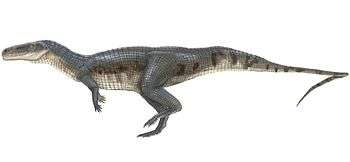Stagonolepis
| Stagonolepis Temporal range: Late Triassic, Carnian | |
|---|---|
 | |
| Skeletal restorations of S. robertsoni | |
| Scientific classification | |
| Kingdom: | Animalia |
| Phylum: | Chordata |
| Class: | Reptilia |
| Order: | †Aetosauria |
| Family: | †Stagonolepididae |
| Genus: | †Stagonolepis Agassiz, 1844 |
| Species | |
Stagonolepis is an extinct genus of stagonolepidid aetosaur known from the Late Triassic (Carnian stage) of Europe.
Description

Stagonolepis robertsoni was about 3 metres (10 ft) long. It was a quadrupedal animal covered in thick armoured scales that ran down the length of the its body. A slow-moving browser, it would have used this heavy body armour to repel attacks from contemporary thecodont carnivores. Stagonolepis had a very small head for its size; it was only 25 centimetres (10 in), accounting for less than 10% of the total body length. It had no teeth in the front of its jaws, but instead had a beak-like tip that arched upwards. This would have allowed it to uproot plants in a similar manner to a modern pig. The peg-like teeth at the back of its mouth would have been suitable for chewing tough vegetation, including horsetails, ferns, and the newly evolved cycads.[1]
Species
.jpg)
Fossil remains of S. robertsoni have been found in Lossiemouth Sandstone of Scotland, while S. olenkae is known from deposits near Krasiejów, Poland. S. olenkae is stratigraphically younger the type species of Stagonolepis, S. robertsoni.[2] The genus Aetosauroides from South America has been considered a junior synonym of Stagonolepis by some paleontologists. Two species of Aetosauroides were named, A. scagliai and A. subsulcatus. In 2002, Andrew B. Heckert and Spencer G. Lucas proposed that smaller specimens of both species belong to Stagonolepis robertsoni, and larger specimens to S. wellesi.[3] S. wellesi itself was originally named Calyptosuchus, a stagonolepidid from the Late Triassic Dockum Group of the United States, which was considered to be a species of Stagonolepis by Murray & Long in 1989. However, most of the sequential studies conclude that both Aetosauroides and Calyptosuchus are valid and monotypic genera, the former occurs only in South America and the latter only in the United States. Stagonolepis is restricted to the Carnian stage of Scotland and Poland.[4][5][6][7]
References
- ↑ Palmer, D., ed. (1999). The Marshall Illustrated Encyclopedia of Dinosaurs and Prehistoric Animals. London: Marshall Editions. p. 96. ISBN 1-84028-152-9.
- ↑ Sulej, Tomasz (2010). "The skull of an early Late Triassic aetosaur and the evolution of the stagonolepidid archosaurian reptiles". Zoological Journal of the Linnean Society. 158 (4): 860–881. doi:10.1111/j.1096-3642.2009.00566.x.
- ↑ Heckert, A.B.; Lucas, S.G. (2002). "South American occurrences of the Adamanian (Late Triassic: latest Carnian) index taxon Stagonolepis (Archosauria: Aetosauria) and their biochronological significance". Journal of Paleontology. 76 (5): 852–863. doi:10.1666/0022-3360(2002)076<0852:SAOOTA>2.0.CO;2.
- ↑ Parker, William G. (2007). "Reassessment of the Aetosaur "Desmatosuchus" chamaensis with a reanalysis of the phylogeny of the Aetosauria (Archosauria:Pseudosuchia)" (PDF). Journal of Systematic Palaeontology. 5: 41–68. doi:10.1017/S1477201906001994.
- ↑ Parker, W. G.; Stocker, M. R.; Irmis, R. B. (2008). "A new desmatosuchine aetosaur (Archosauria; Suchia) from the Upper Triassic Tecovas Formation (Dockum Group) of Texas". Journal of Vertebrate Paleontology. 28 (2): 692–701. doi:10.1671/0272-4634(2008)28[692:ANDAAS]2.0.CO;2. ISSN 0272-4634.
- ↑ Desojo, J.B.; Ezcurra, M.D. (2011). "A reappraisal of the taxonomic status of Aetosauroides (Archosauria, Aetosauria) specimens from the Late Triassic of South America and their proposed synonymy with Stagonolepis". Journal of Vertebrate Paleontology. 31 (3): 596–609. doi:10.1080/02724634.2011.572936.
- ↑ Julia B. Desojo, Martin D. Ezcurra and Edio E. Kischlat (2012). "A new aetosaur genus (Archosauria: Pseudosuchia) from the early Late Triassic of southern Brazil" (PDF). Zootaxa. 3166: 1–33. ISSN 1175-5326.



